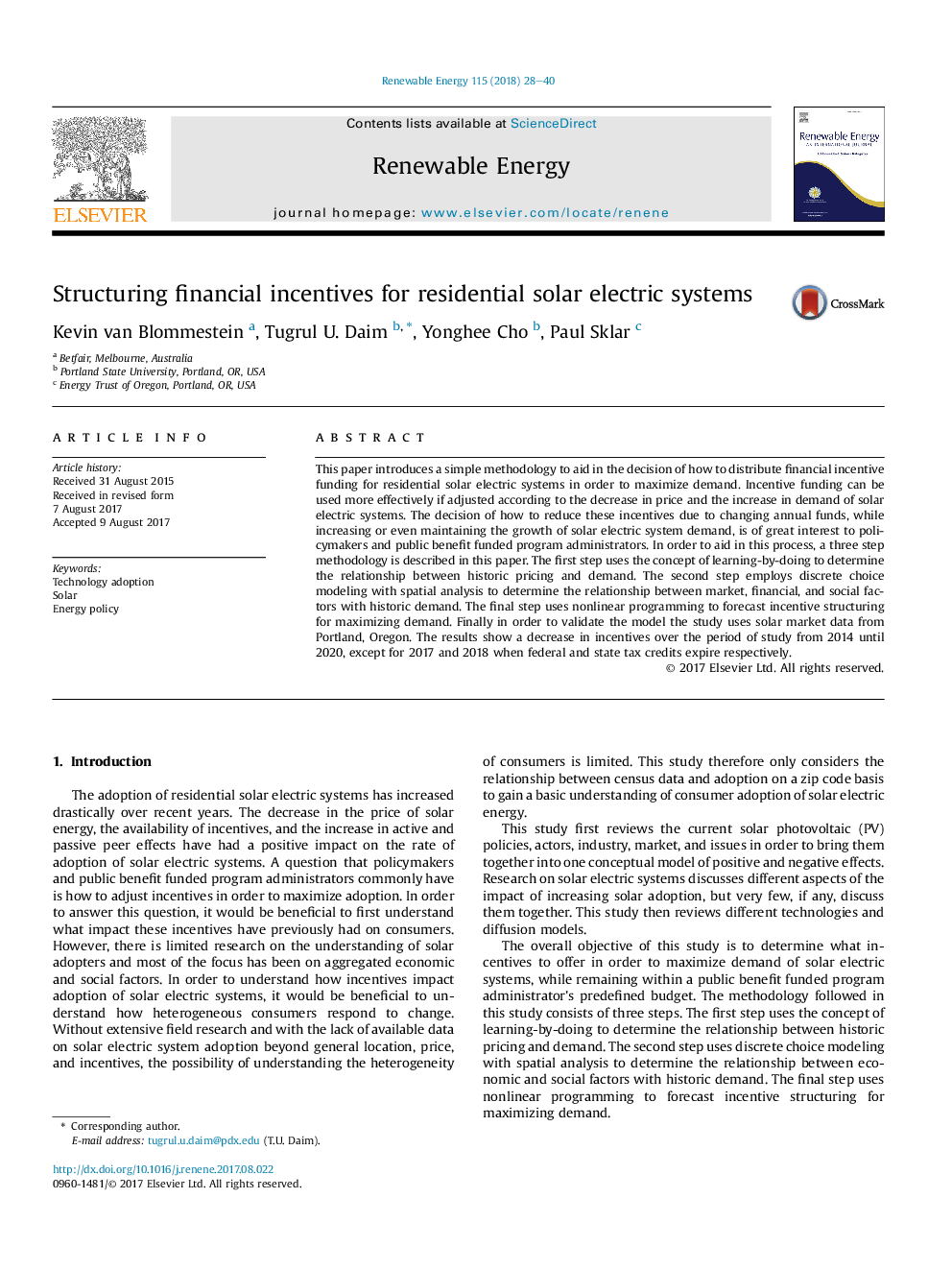| کد مقاله | کد نشریه | سال انتشار | مقاله انگلیسی | نسخه تمام متن |
|---|---|---|---|---|
| 6765172 | 1431590 | 2018 | 13 صفحه PDF | دانلود رایگان |
عنوان انگلیسی مقاله ISI
Structuring financial incentives for residential solar electric systems
ترجمه فارسی عنوان
ایجاد مشوق های مالی برای سیستم های برق خورشیدی مسکونی
دانلود مقاله + سفارش ترجمه
دانلود مقاله ISI انگلیسی
رایگان برای ایرانیان
کلمات کلیدی
پذیرش فناوری، خورشیدی، سیاست انرژی،
ترجمه چکیده
این مقاله یک روش ساده برای کمک به تصمیم گیری در مورد نحوه توزیع بودجه کمک های مالی برای سیستم های برق خورشیدی مسکونی به منظور حداکثر کردن تقاضا معرفی می کند. با توجه به کاهش قیمت و افزایش تقاضا از سیستم های برق خورشیدی، می توان از بودجه کمک های مالی استفاده کرد. تصمیم گیری در مورد چگونگی کاهش این انگیزه ها با توجه به تغییر بودجه سالانه، در حالی که افزایش یا حتی حفظ رشد تقاضای سیستم برق خورشیدی، علاقه مندان به سیاست گذاران و مدیران برنامه های تحت پوشش بودجه عمومی است. به منظور کمک به این روند، یک روش سه گام در این مقاله شرح داده شده است. گام اول از مفهوم یادگیری توسط انجام کار برای تعیین رابطه بین قیمت تاریخی و تقاضا استفاده می کند. گام دوم، مدل سازی انتخاب گسسته با تجزیه و تحلیل فضایی را برای تعیین رابطه بین عوامل بازار، مالی و اجتماعی با تقاضای تاریخی، مورد استفاده قرار می دهد. مرحله نهایی برنامه نویسی غیر خطی را برای پیش بینی ساختار انگیزشی برای حداکثر کردن تقاضا استفاده می کند. در نهایت به منظور اعتبار مدل، مطالعه از اطلاعات بازار خورشید از پورتلند، اورگان استفاده می کند. نتایج نشان می دهد کاهش انگیزه ها در دوره تحصیل از سال 2014 تا 2020، به جز سال های 2017 و 2018، زمانی که وام های مالیاتی ایالتی و ایالتی به ترتیب منقضی می شوند.
موضوعات مرتبط
مهندسی و علوم پایه
مهندسی انرژی
انرژی های تجدید پذیر، توسعه پایدار و محیط زیست
چکیده انگلیسی
This paper introduces a simple methodology to aid in the decision of how to distribute financial incentive funding for residential solar electric systems in order to maximize demand. Incentive funding can be used more effectively if adjusted according to the decrease in price and the increase in demand of solar electric systems. The decision of how to reduce these incentives due to changing annual funds, while increasing or even maintaining the growth of solar electric system demand, is of great interest to policymakers and public benefit funded program administrators. In order to aid in this process, a three step methodology is described in this paper. The first step uses the concept of learning-by-doing to determine the relationship between historic pricing and demand. The second step employs discrete choice modeling with spatial analysis to determine the relationship between market, financial, and social factors with historic demand. The final step uses nonlinear programming to forecast incentive structuring for maximizing demand. Finally in order to validate the model the study uses solar market data from Portland, Oregon. The results show a decrease in incentives over the period of study from 2014 until 2020, except for 2017 and 2018 when federal and state tax credits expire respectively.
ناشر
Database: Elsevier - ScienceDirect (ساینس دایرکت)
Journal: Renewable Energy - Volume 115, January 2018, Pages 28-40
Journal: Renewable Energy - Volume 115, January 2018, Pages 28-40
نویسندگان
Kevin van Blommestein, Tugrul U. Daim, Yonghee Cho, Paul Sklar,
